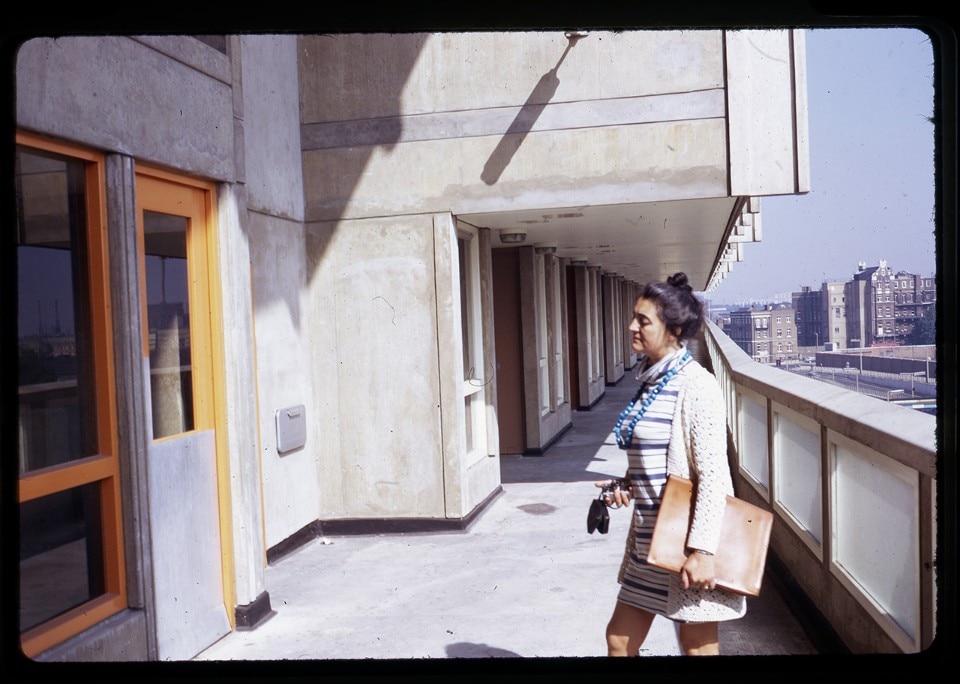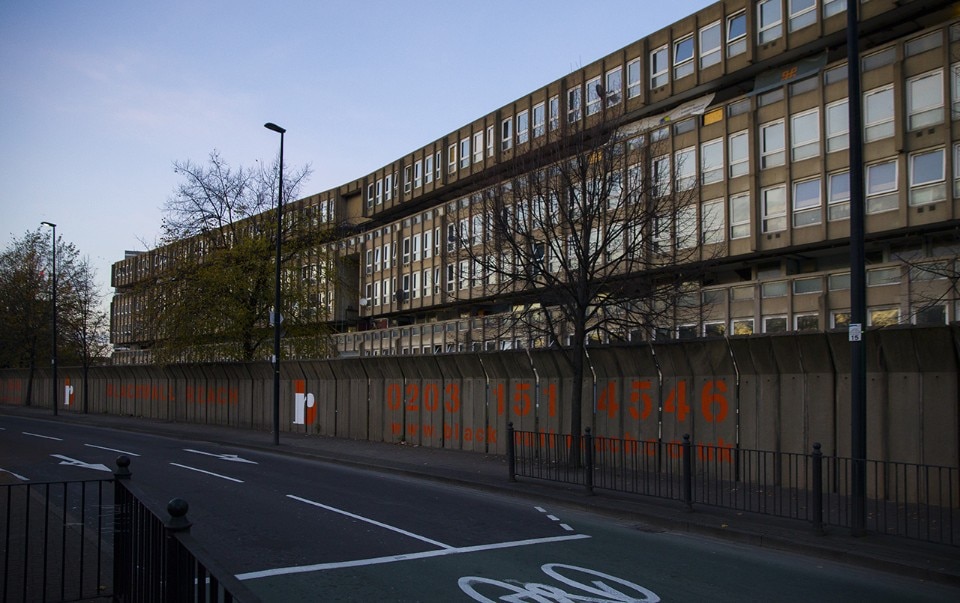This year, as part of the 16th International Architecture Exhibition in Venice, the Victoria and Albert Museum in London exhibited a rather unusual object at the Applied Arts Pavilion: a section of the facade of Robin Hood Gardens, the only council estate designed by the architects Alison and Peter Smithson, and completed in 1972.
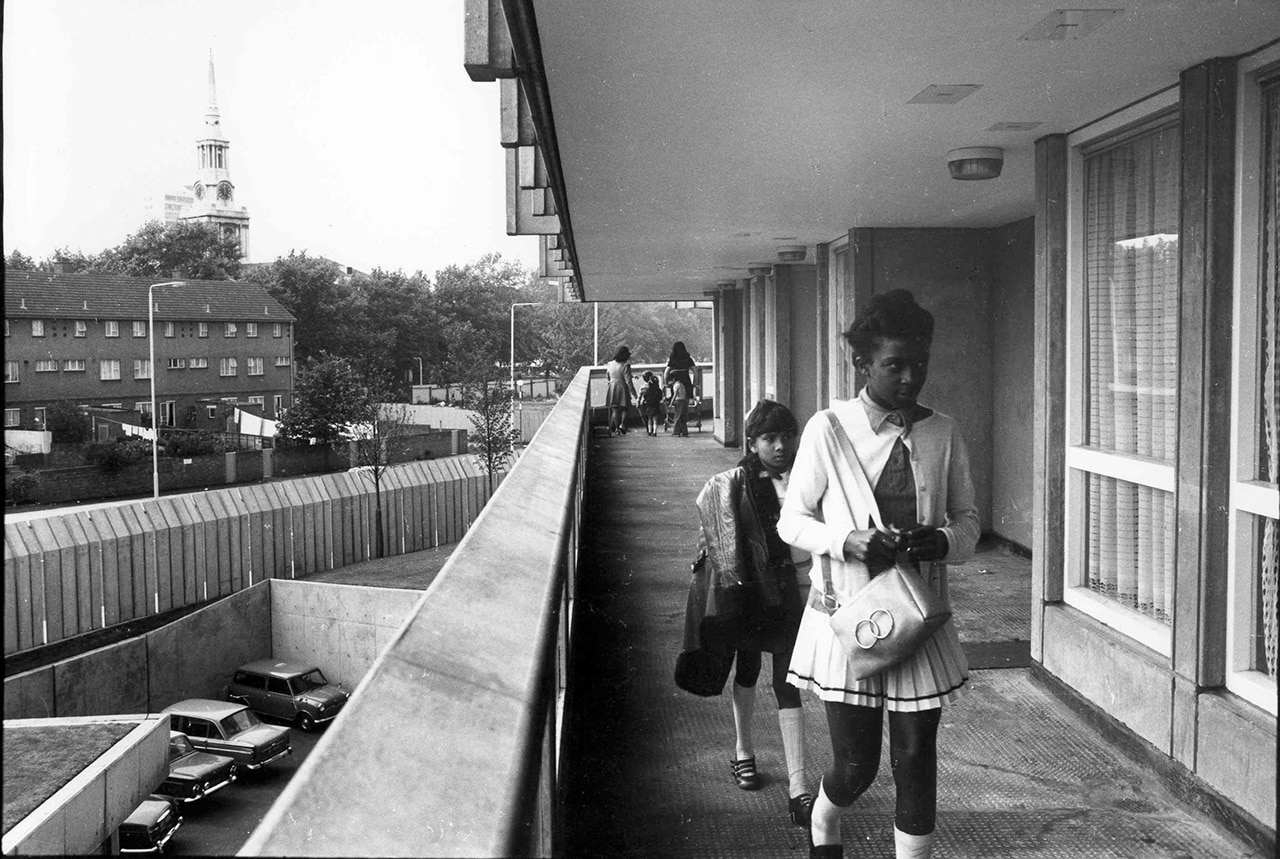
 View gallery
View gallery
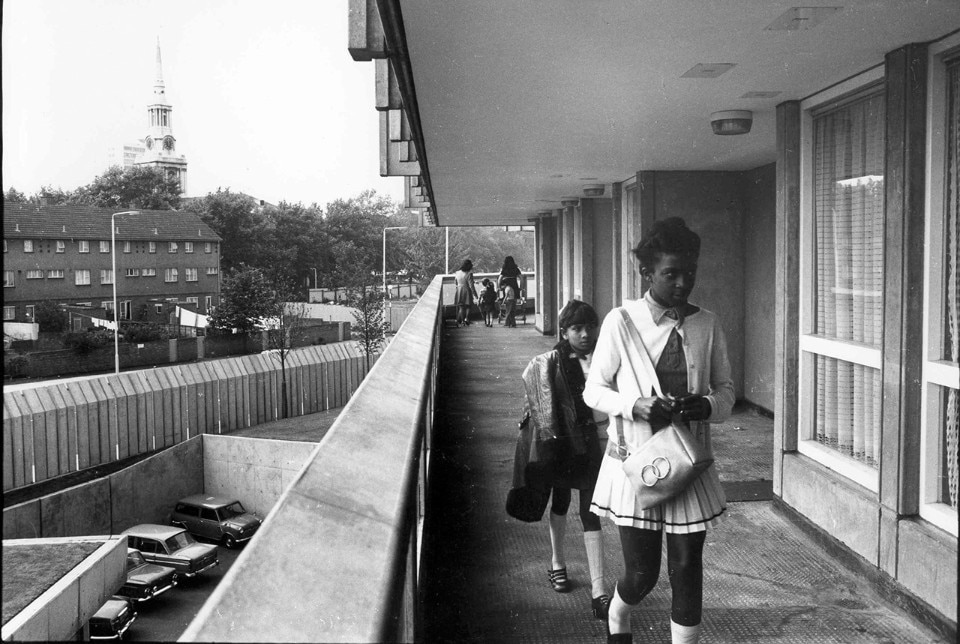
Archive images of the Robin Hood Gardens by Alison and Peter Smithson
The Robin Hood Gardens represents an attempt to overcome the design rigidity of the modern movement’s pioneers regarding housing estates. According to the historian and critic Reyner Banham, the Smithsons’ design was “Architecture of the Second Machine Age”.
Girl on a Street in the Sky, Robin Hood Gardens, 1972. Photograph © Sandra Lousada
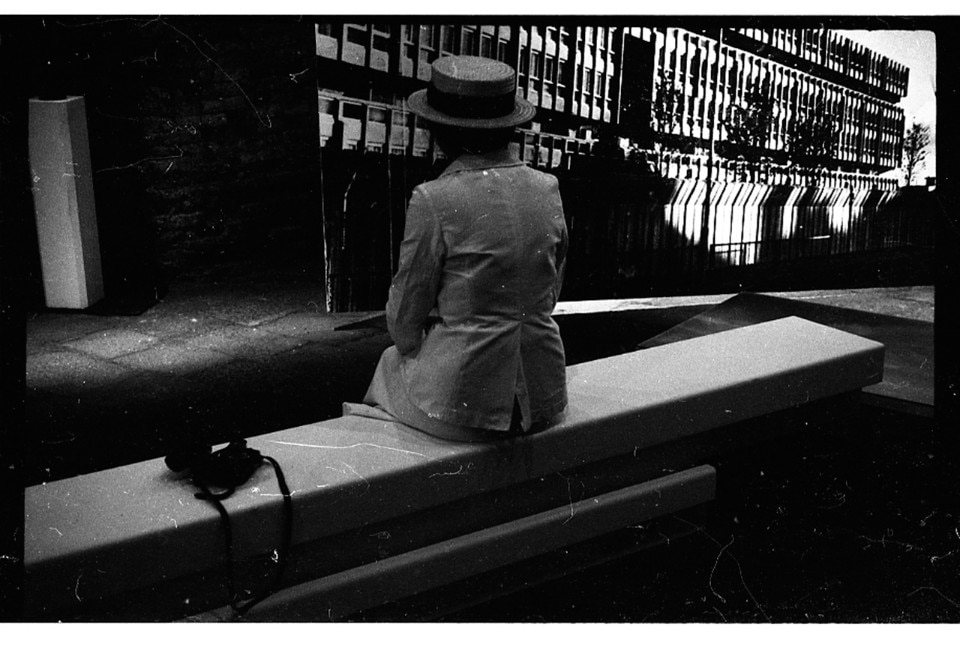
Archive images of the Robin Hood Gardens by Alison and Peter Smithson
The Robin Hood Gardens represents an attempt to overcome the design rigidity of the modern movement’s pioneers regarding housing estates. According to the historian and critic Reyner Banham, the Smithsons’ design was “Architecture of the Second Machine Age”.
Alison Smithson at the 1976 Venice Biennale, photographed by Peter Smithson, 1976. Courtesy of the Smithson Family Collection
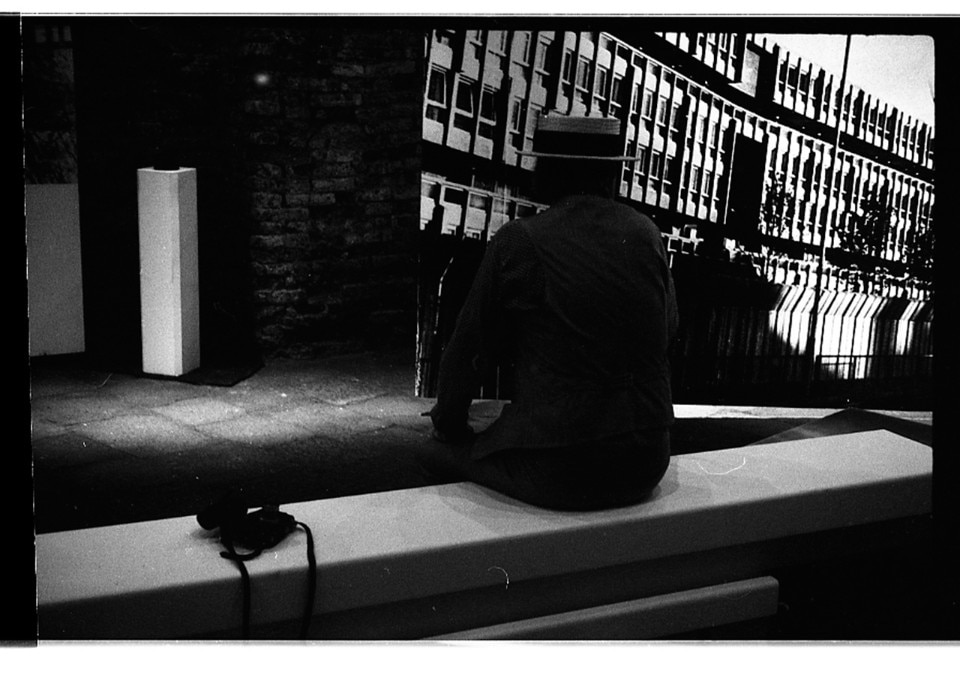
Archive images of the Robin Hood Gardens by Alison and Peter Smithson
The Robin Hood Gardens represents an attempt to overcome the design rigidity of the modern movement’s pioneers regarding housing estates. According to the historian and critic Reyner Banham, the Smithsons’ design was “Architecture of the Second Machine Age”.
Peter Smithson at the 1976 Venice Biennale, photographed by Alison Smithson, 1976. Courtesy of the Smithson Family Collection
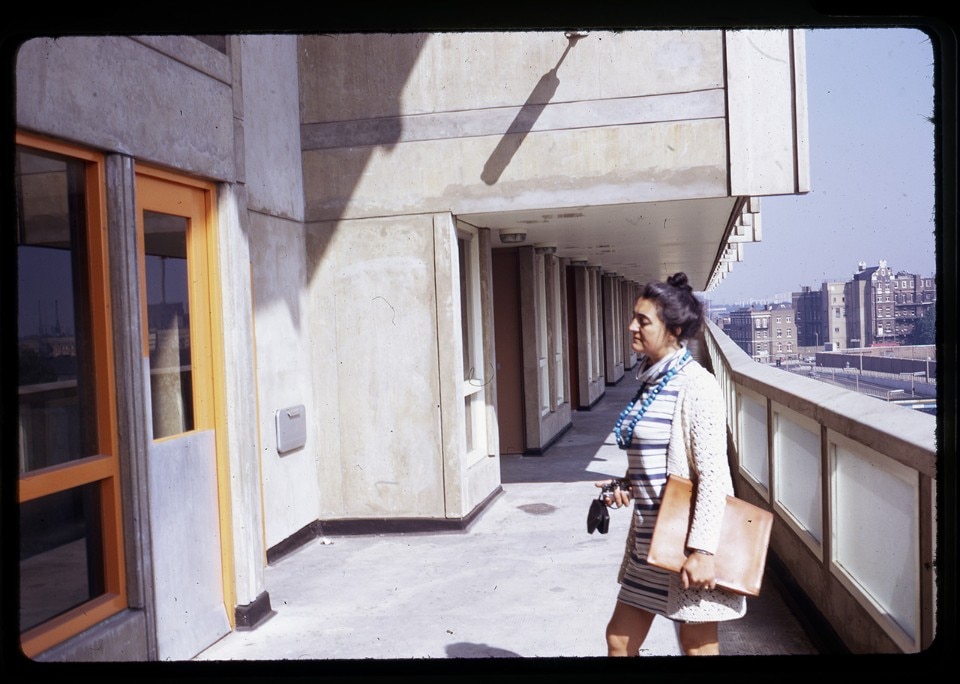
Archive images of the Robin Hood Gardens by Alison and Peter Smithson
The Robin Hood Gardens represents an attempt to overcome the design rigidity of the modern movement’s pioneers regarding housing estates. According to the historian and critic Reyner Banham, the Smithsons’ design was “Architecture of the Second Machine Age”.
Deck of Robin Hood Gardens with Alison Smithson, photographed by Peter Smithson,
about 1970. Courtesy of the Smithson Family Collection
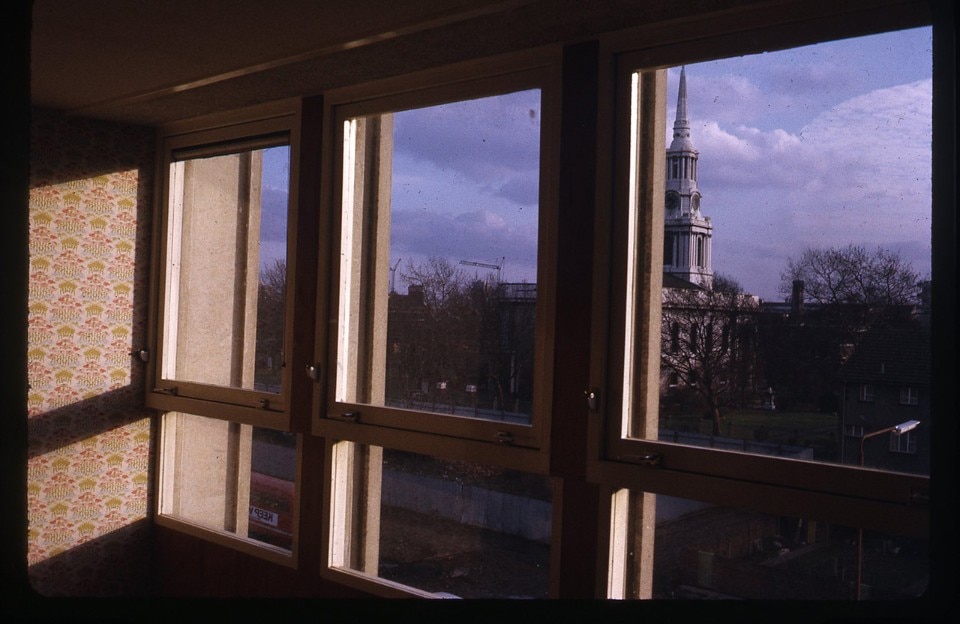
Archive images of the Robin Hood Gardens by Alison and Peter Smithson
The Robin Hood Gardens represents an attempt to overcome the design rigidity of the modern movement’s pioneers regarding housing estates. According to the historian and critic Reyner Banham, the Smithsons’ design was “Architecture of the Second Machine Age”.
Slides of interiors, circa 1970, by Peter Smithson. Courtesy of The Smithson Family Collection
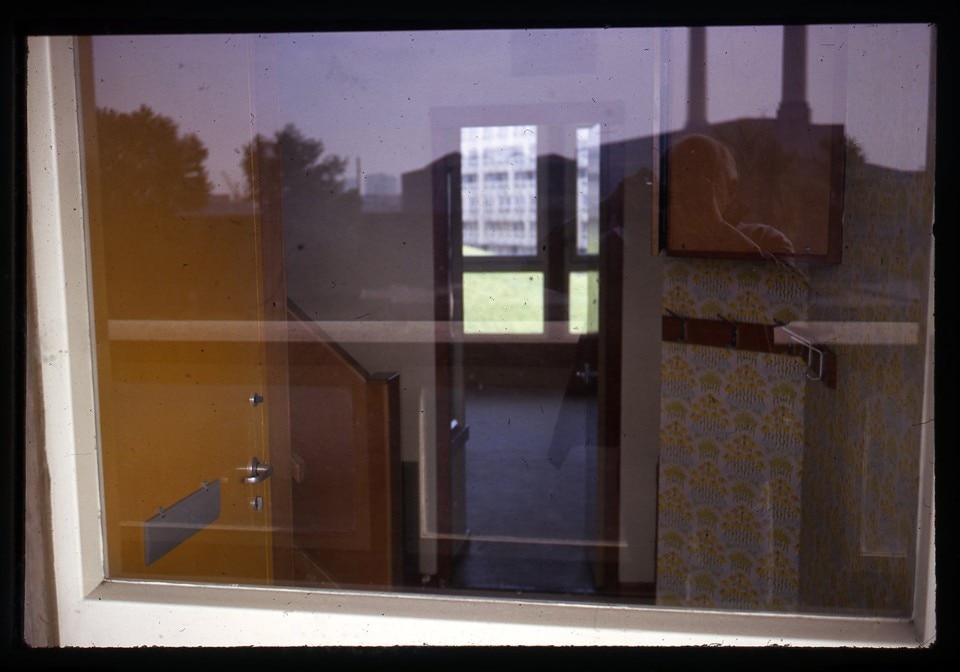
Archive images of the Robin Hood Gardens by Alison and Peter Smithson
The Robin Hood Gardens represents an attempt to overcome the design rigidity of the modern movement’s pioneers regarding housing estates. According to the historian and critic Reyner Banham, the Smithsons’ design was “Architecture of the Second Machine Age”.
Slides of interiors, circa 1970, by Peter Smithson. Courtesy of The Smithson Family Collection
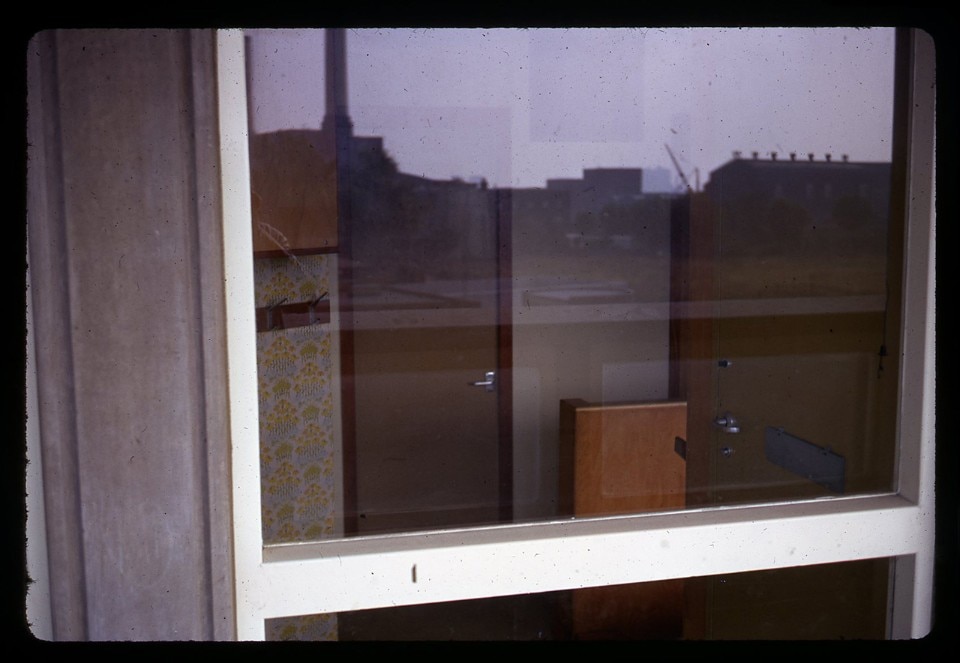
Archive images of the Robin Hood Gardens by Alison and Peter Smithson
The Robin Hood Gardens represents an attempt to overcome the design rigidity of the modern movement’s pioneers regarding housing estates. According to the historian and critic Reyner Banham, the Smithsons’ design was “Architecture of the Second Machine Age”.
Slides of interiors, circa 1970, by Peter Smithson. Courtesy of The Smithson Family Collection
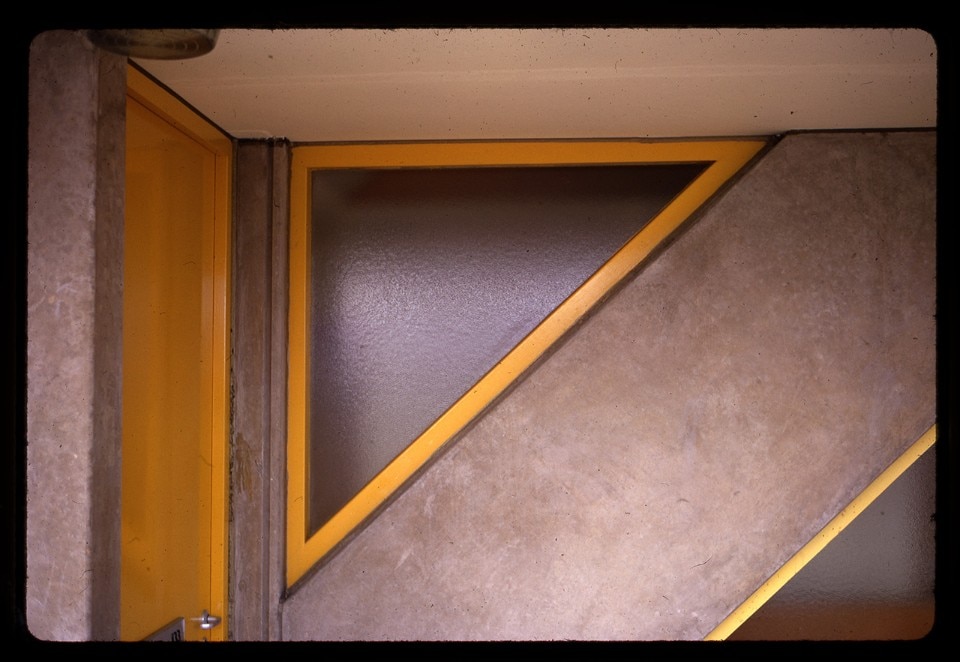
Archive images of the Robin Hood Gardens by Alison and Peter Smithson
The Robin Hood Gardens represents an attempt to overcome the design rigidity of the modern movement’s pioneers regarding housing estates. According to the historian and critic Reyner Banham, the Smithsons’ design was “Architecture of the Second Machine Age”.
Yellow triangle detail of Robin Hood Gardens circa 1970, photographed by Peter Smithson. Photo courtesy of The Smithson Family Collection
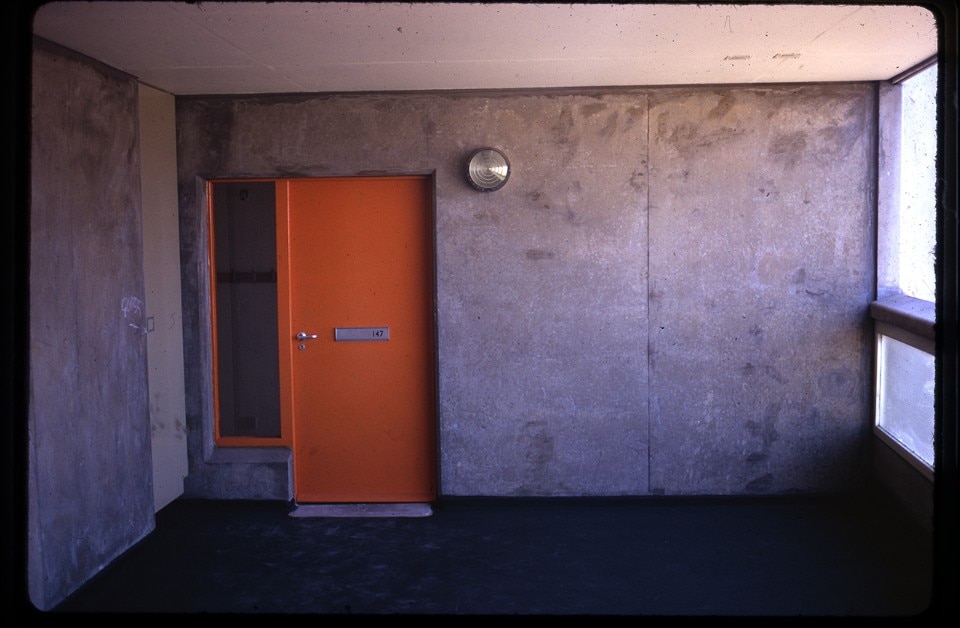
Archive images of the Robin Hood Gardens by Alison and Peter Smithson
The Robin Hood Gardens represents an attempt to overcome the design rigidity of the modern movement’s pioneers regarding housing estates. According to the historian and critic Reyner Banham, the Smithsons’ design was “Architecture of the Second Machine Age”.
Door of Robin Hood Gardens, circa 1970, photographed by Peter Smithson. Photo courtesy of The Smithson Family Collection

Archive images of the Robin Hood Gardens by Alison and Peter Smithson
The Robin Hood Gardens represents an attempt to overcome the design rigidity of the modern movement’s pioneers regarding housing estates. According to the historian and critic Reyner Banham, the Smithsons’ design was “Architecture of the Second Machine Age”.
Girl on a Street in the Sky, Robin Hood Gardens, 1972. Photograph © Sandra Lousada

Archive images of the Robin Hood Gardens by Alison and Peter Smithson
The Robin Hood Gardens represents an attempt to overcome the design rigidity of the modern movement’s pioneers regarding housing estates. According to the historian and critic Reyner Banham, the Smithsons’ design was “Architecture of the Second Machine Age”.
Alison Smithson at the 1976 Venice Biennale, photographed by Peter Smithson, 1976. Courtesy of the Smithson Family Collection

Archive images of the Robin Hood Gardens by Alison and Peter Smithson
The Robin Hood Gardens represents an attempt to overcome the design rigidity of the modern movement’s pioneers regarding housing estates. According to the historian and critic Reyner Banham, the Smithsons’ design was “Architecture of the Second Machine Age”.
Peter Smithson at the 1976 Venice Biennale, photographed by Alison Smithson, 1976. Courtesy of the Smithson Family Collection

Archive images of the Robin Hood Gardens by Alison and Peter Smithson
The Robin Hood Gardens represents an attempt to overcome the design rigidity of the modern movement’s pioneers regarding housing estates. According to the historian and critic Reyner Banham, the Smithsons’ design was “Architecture of the Second Machine Age”.
Deck of Robin Hood Gardens with Alison Smithson, photographed by Peter Smithson,
about 1970. Courtesy of the Smithson Family Collection

Archive images of the Robin Hood Gardens by Alison and Peter Smithson
The Robin Hood Gardens represents an attempt to overcome the design rigidity of the modern movement’s pioneers regarding housing estates. According to the historian and critic Reyner Banham, the Smithsons’ design was “Architecture of the Second Machine Age”.
Slides of interiors, circa 1970, by Peter Smithson. Courtesy of The Smithson Family Collection

Archive images of the Robin Hood Gardens by Alison and Peter Smithson
The Robin Hood Gardens represents an attempt to overcome the design rigidity of the modern movement’s pioneers regarding housing estates. According to the historian and critic Reyner Banham, the Smithsons’ design was “Architecture of the Second Machine Age”.
Slides of interiors, circa 1970, by Peter Smithson. Courtesy of The Smithson Family Collection

Archive images of the Robin Hood Gardens by Alison and Peter Smithson
The Robin Hood Gardens represents an attempt to overcome the design rigidity of the modern movement’s pioneers regarding housing estates. According to the historian and critic Reyner Banham, the Smithsons’ design was “Architecture of the Second Machine Age”.
Slides of interiors, circa 1970, by Peter Smithson. Courtesy of The Smithson Family Collection

Archive images of the Robin Hood Gardens by Alison and Peter Smithson
The Robin Hood Gardens represents an attempt to overcome the design rigidity of the modern movement’s pioneers regarding housing estates. According to the historian and critic Reyner Banham, the Smithsons’ design was “Architecture of the Second Machine Age”.
Yellow triangle detail of Robin Hood Gardens circa 1970, photographed by Peter Smithson. Photo courtesy of The Smithson Family Collection

Archive images of the Robin Hood Gardens by Alison and Peter Smithson
The Robin Hood Gardens represents an attempt to overcome the design rigidity of the modern movement’s pioneers regarding housing estates. According to the historian and critic Reyner Banham, the Smithsons’ design was “Architecture of the Second Machine Age”.
Door of Robin Hood Gardens, circa 1970, photographed by Peter Smithson. Photo courtesy of The Smithson Family Collection
At the end of the postwar welfare policies and just before the 1973 oil crisis and the subsequent recession, the building was one of the emblematic experiments of the three decades following World War II. It is now under demolition in anticipation of a new development called Blackwall Reach, comprising 1,575 residential units compared to the 213 of Robin Hood Gardens. The announcement to tear down the old complex was met with criticism and disapproval from the international architectural community, which led to several attempts to list the property, in other words to recognise its historical value and therefore protect the building. The requests were declined by English Heritage. The demolition is scheduled to be completed by 2019 and in the meantime the Victoria and Albert Museum in London has started a research project that involves the recovery and conservation of some portions of the complex. This has sparked a new interest in the old complex, which represents an attempt to overcome the design rigidity of the modern movement’s pioneers regarding housing estates. According to the historian and critic Reyner Banham, the Smithsons’ design was “Architecture of the Second Machine Age”.
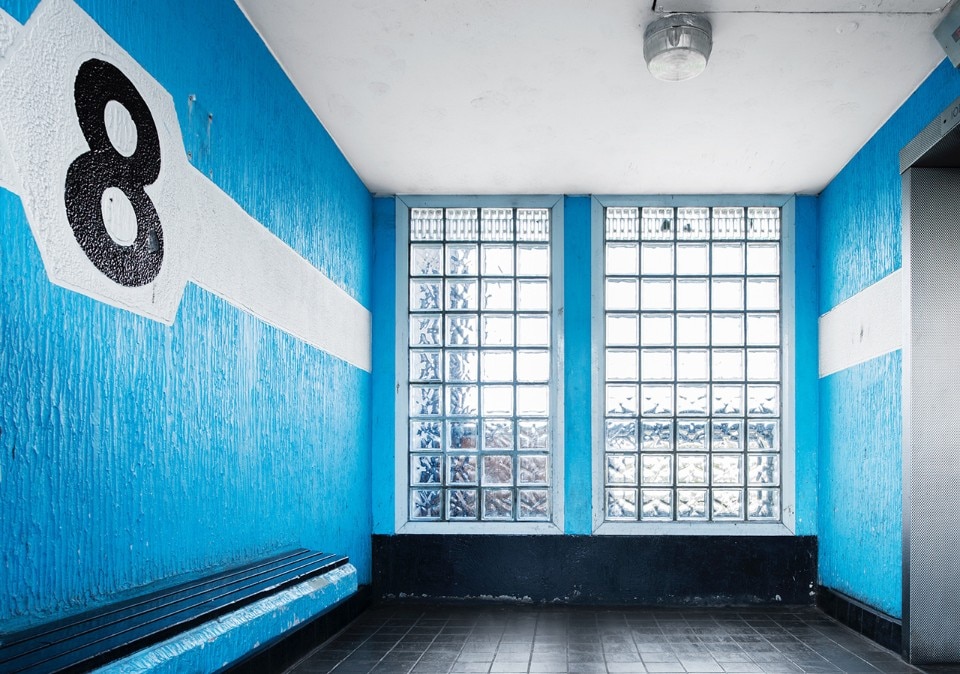
The Smithsons’ ideas were formed within the CIAM, the International Congresses of Modern Architecture, and it was within the same movement that Team X was born in 1953. Members included Giancarlo De Carlo, Jaap Bakema and Aldo van Eyck. The group focused its design on the understanding of social contexts and was interested in giving new quality to housing. The origin of these ideas can be found in the Smithsons’ work within the Independent Group which dates back to the early 1950s. This collaboration with artists, writers and critics such as Eduardo Paolozzi, Richard Hamilton, Nigel Henderson and Banham introduced to the cultural debate the themes of mass culture and the relationship with technology. In particular, the documentation of life in the East End suburb of Bethnal Green, London by the photographer Nigel Henderson correlated with the Smithsons' interest in “human facts” (see the volume Team 10 Primer edited by Alison Smithson, Studio Vista Limited, London 1968).
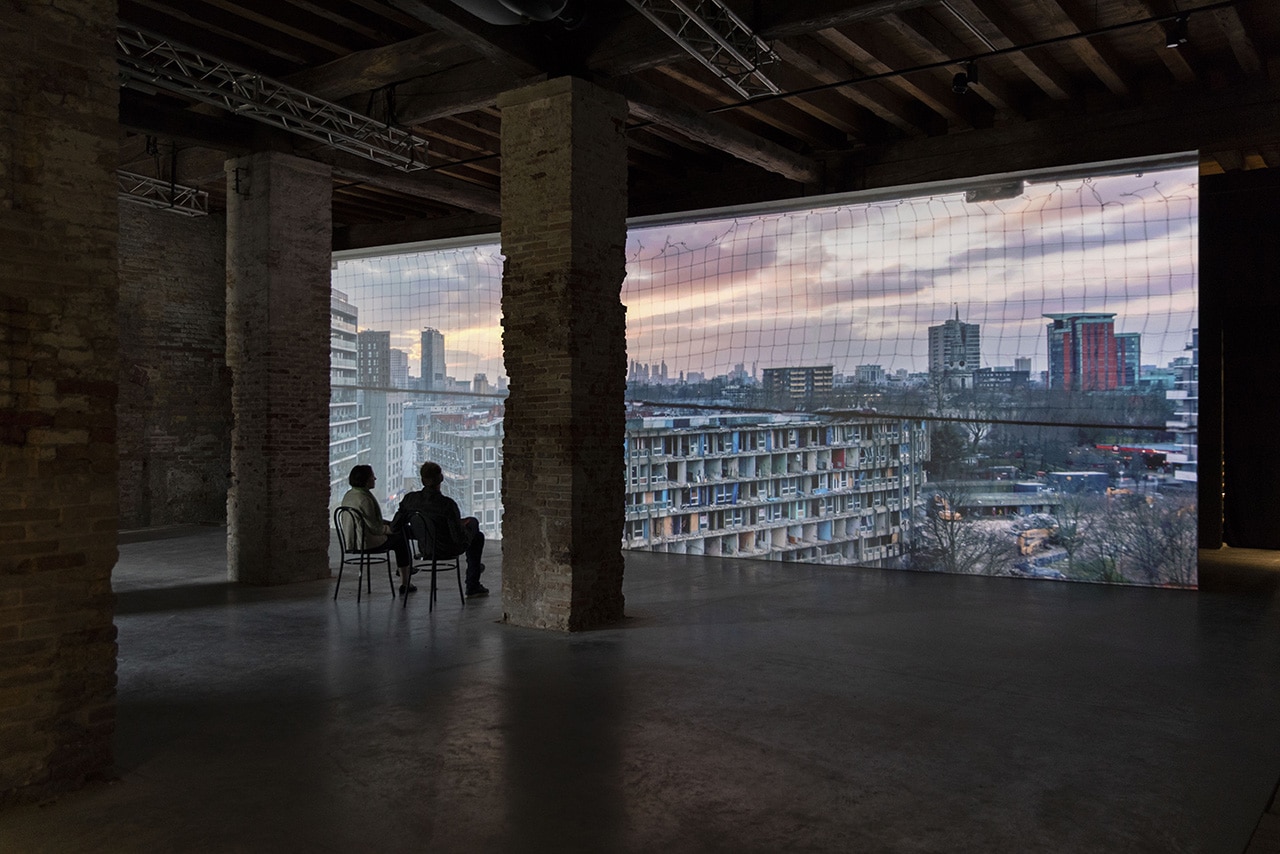
 View gallery
View gallery
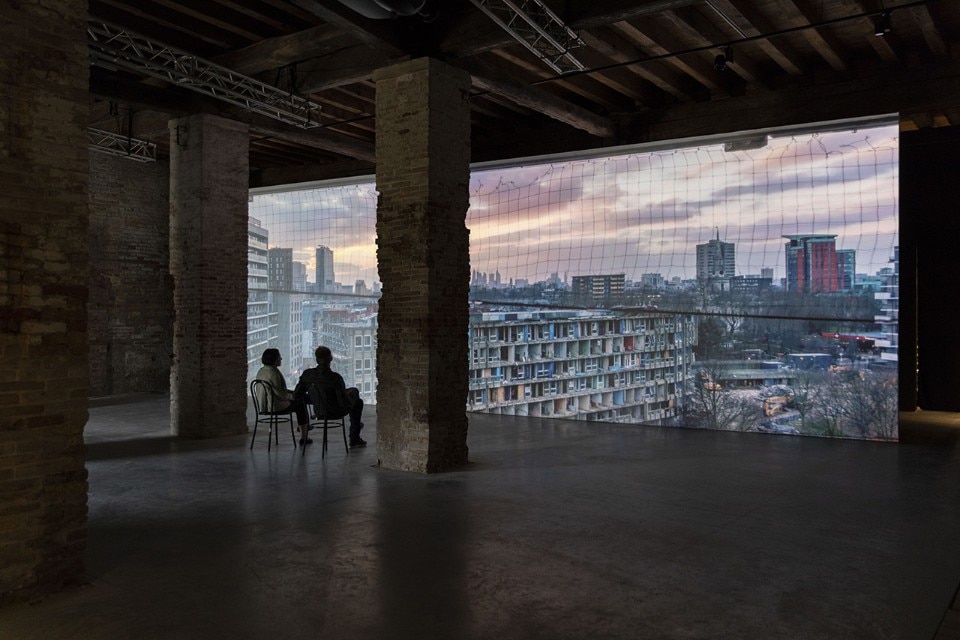
Robin Hood Gardens, Woolmore Street, London E14 0HG by Do Ho Suh commissioned by the V&A. Courtesy of the Artist, Lehmann Maupin, New York Hong Kong and Seoul and
Victoria Miro London / Venice. Photo Copyright © Victoria and Albert Museum, London
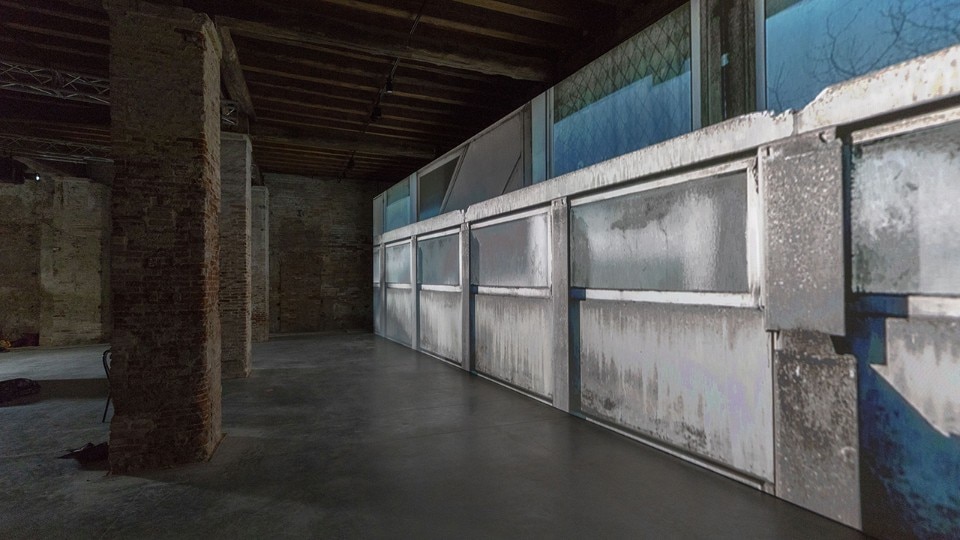
Robin Hood Gardens, Woolmore Street, London E14 0HG by Do Ho Suh commissioned by the V&A. Courtesy of the Artist, Lehmann Maupin, New York Hong Kong and Seoul and
Victoria Miro London / Venice. Photo Copyright © Victoria and Albert Museum, London
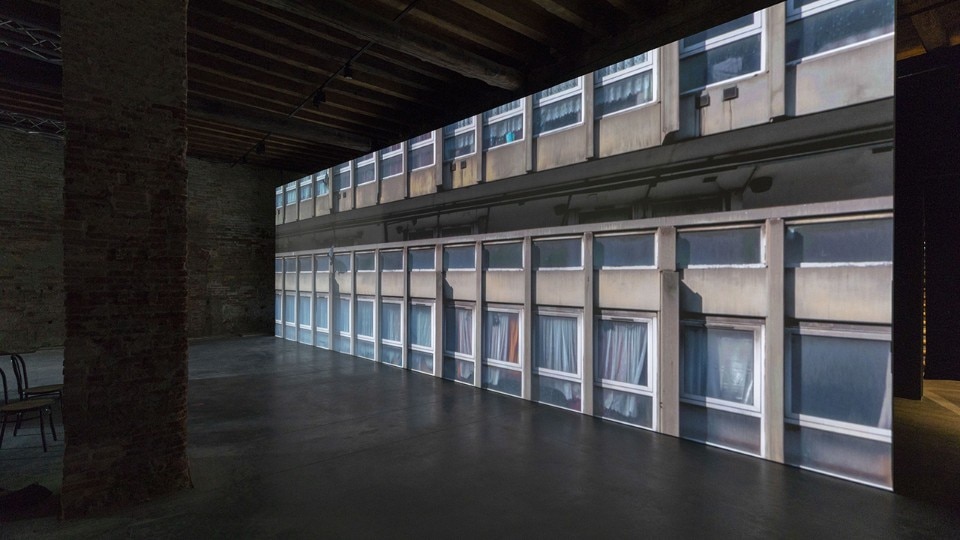
Robin Hood Gardens, Woolmore Street, London E14 0HG by Do Ho Suh commissioned by the V&A. Courtesy of the Artist, Lehmann Maupin, New York Hong Kong and Seoul and
Victoria Miro London / Venice. Photo Copyright © Victoria and Albert Museum, London
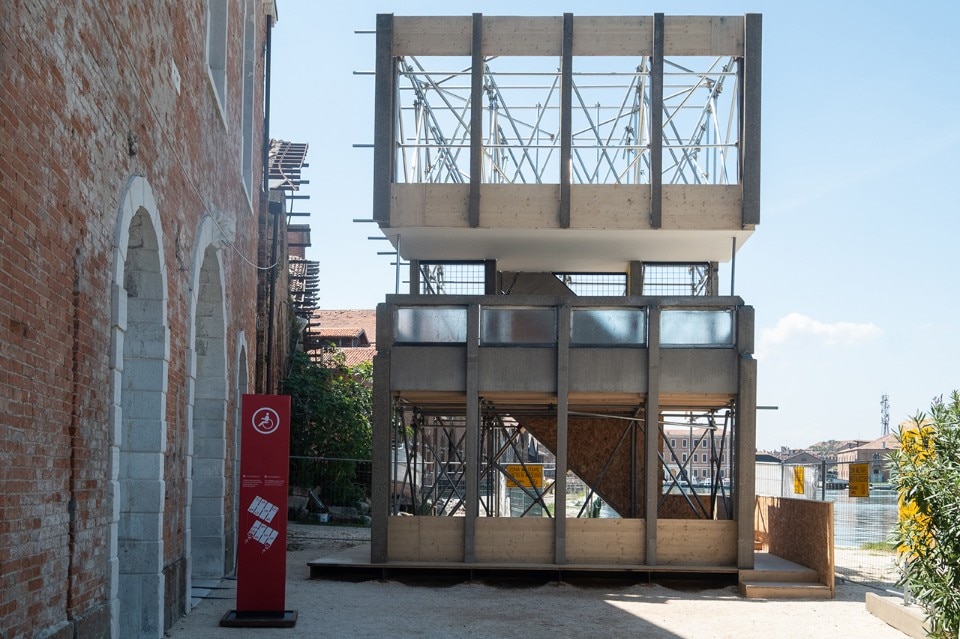
Reassembled fragment of the façade of Robin Hood Gardens, Pavilion of Applied Arts, La Biennale di Venezia, 2018. Photography: Mohamed Somji Photo Copyright © Victoria and Albert Museum, London.
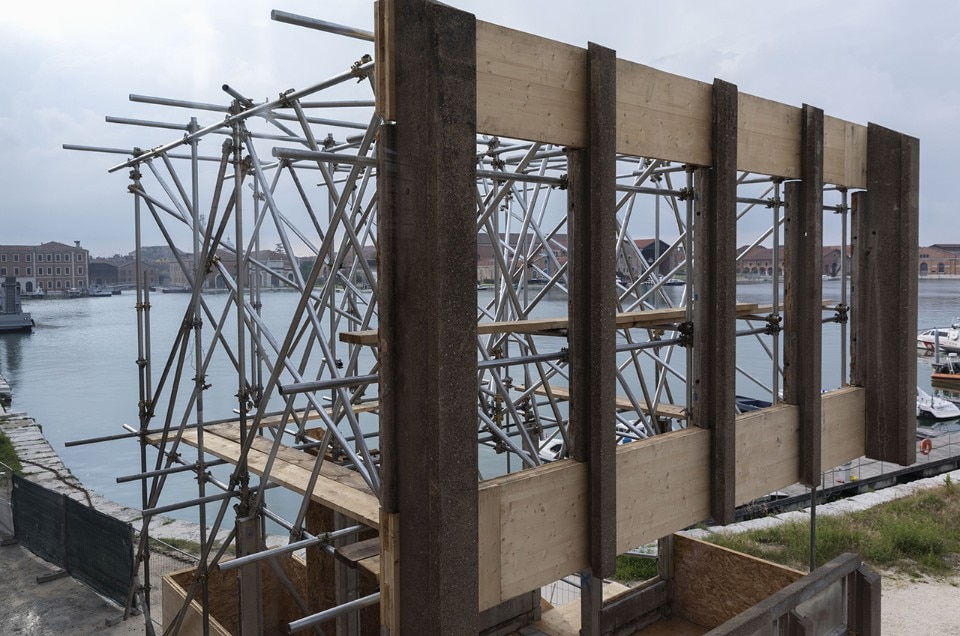
View of upper storey of the fragment of Robin Hood Gardens, Pavilion of Applied Arts, La Biennale di Venezia, 2018. Copyright © Victoria and Albert Museum, London.
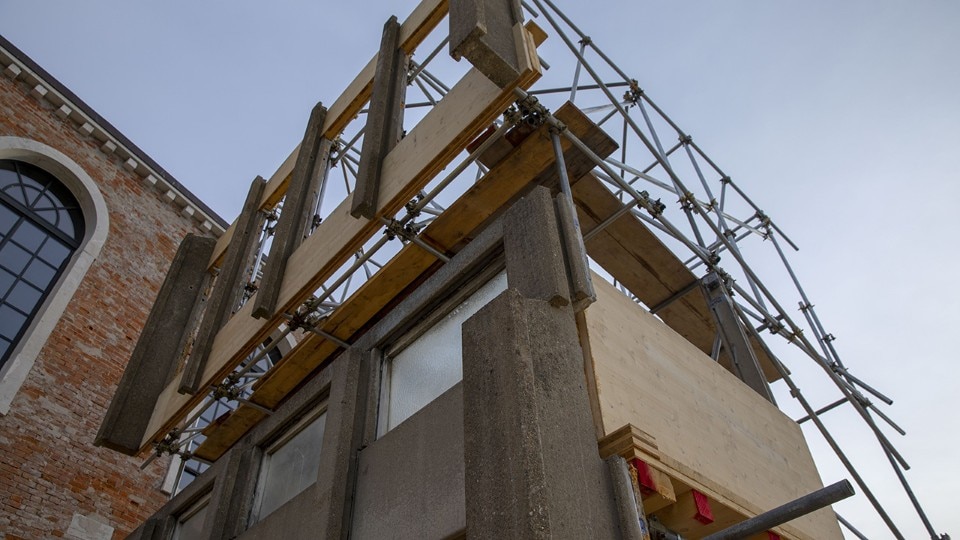
Side view of reassembled fragment of the façade of Robin Hood Gardens, Pavilion of Applied Arts, La Biennale di Venezia, 2018. Copyright © Victoria and Albert Museum, London.
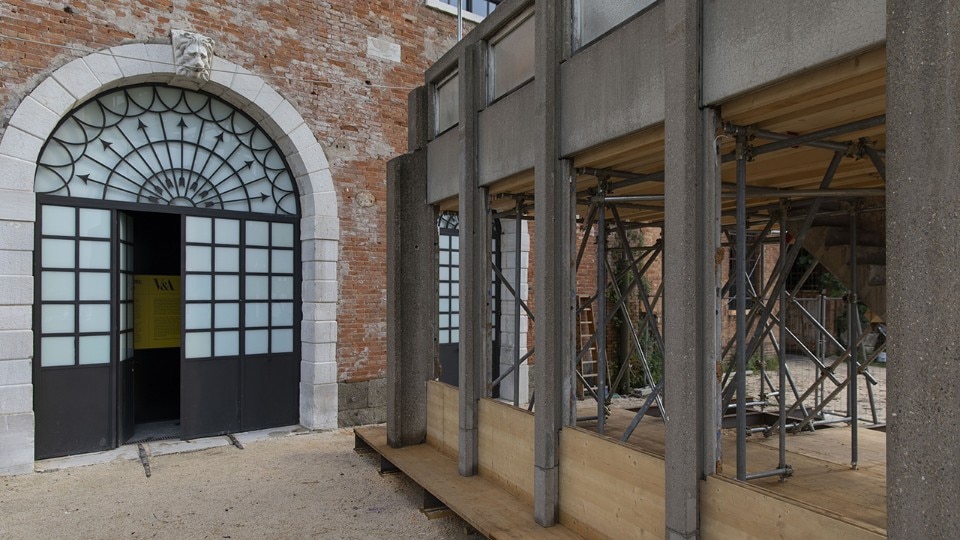
Ground level façade and stairs, reassembled fragment of Robin Hood Gardens, Pavilion of Applied Arts, La Biennale di Venezia, 2018. Copyright © Victoria and Albert Museum,
London.
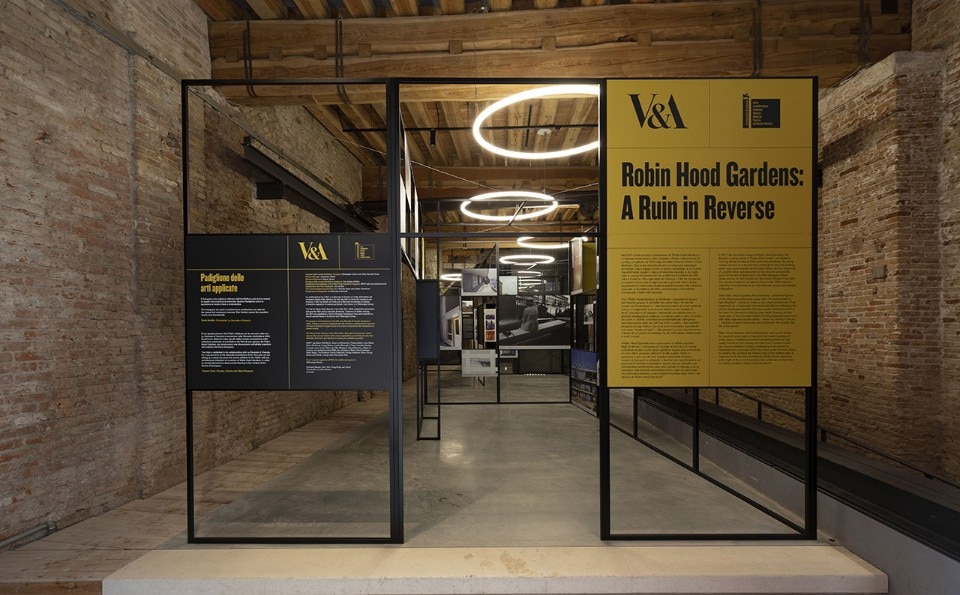
Exhibition entrance, Robin Hood Gardens: A Ruin In Reverse, Pavilion of Applied Arts, La Biennale di Venezia, 2018. Copyright © Victoria and Albert Museum, London.
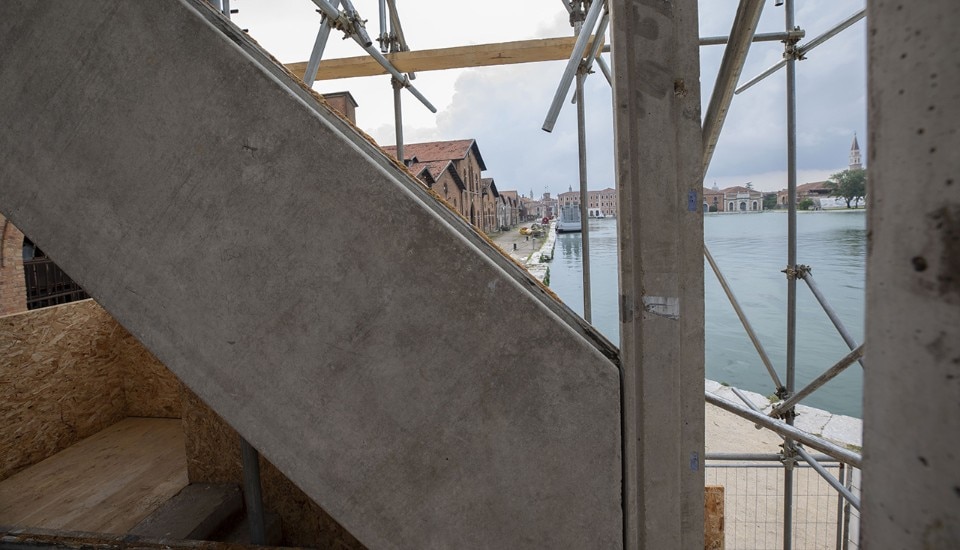
Staircase to the street-in-the-sky, reassembled fragment of Robin Hood Gardens, Pavilion of Applied Arts, La Biennale di Venezia, 2018. Copyright © Victoria and Albert Museum,
London.

View from the street-in-the-sky, Robin Hood Gardens: A Ruin In Reverse, Pavilion of Applied Arts, La Biennale di Venezia, 2018. Copyright © Victoria and Albert Museum, London.
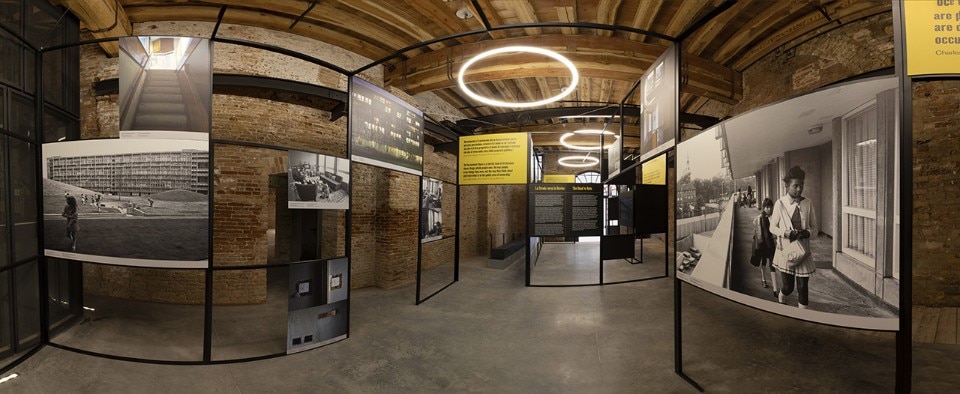
Robin Hood Gardens: A Ruin In Reverse, Pavilion of Applied Arts, La Biennale di Venezia, 2018. Copyright © Victoria and Albert Museum, London.
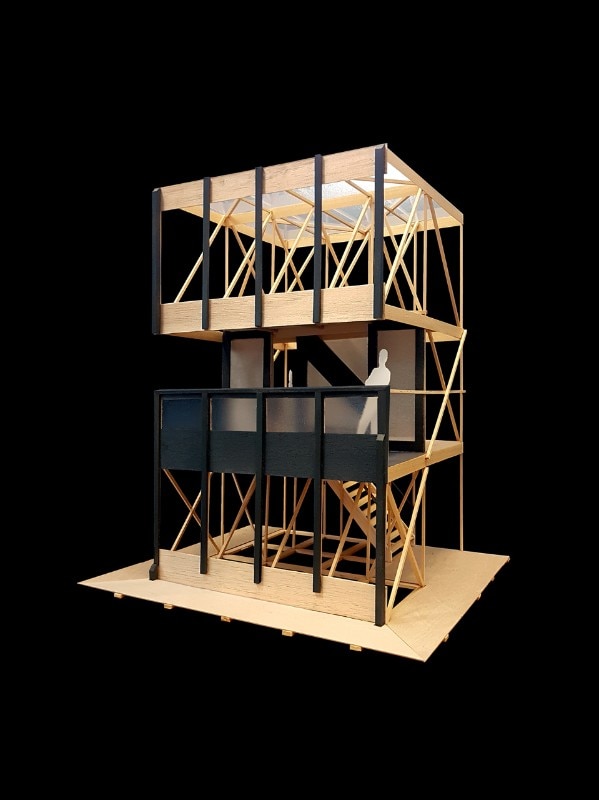
Model of the Robin Hood Gardens fragments supported by scaffolding, 2018. © muf architecture art
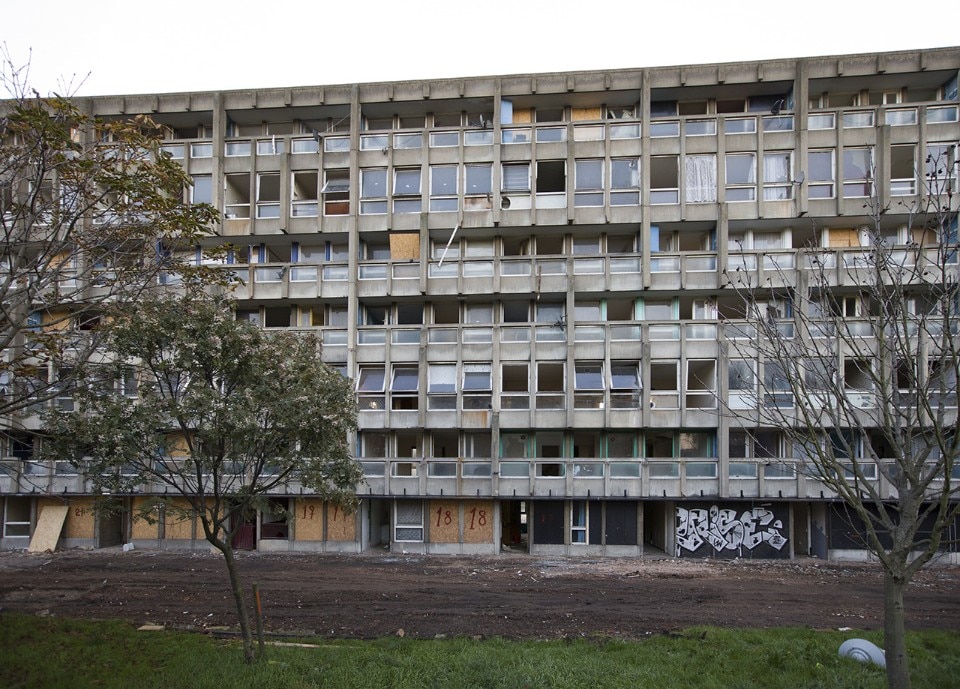
Robin Hood Gardens, completed 1972, designed by Alison and Peter Smithson. © The Victoria and Albert Museum, London
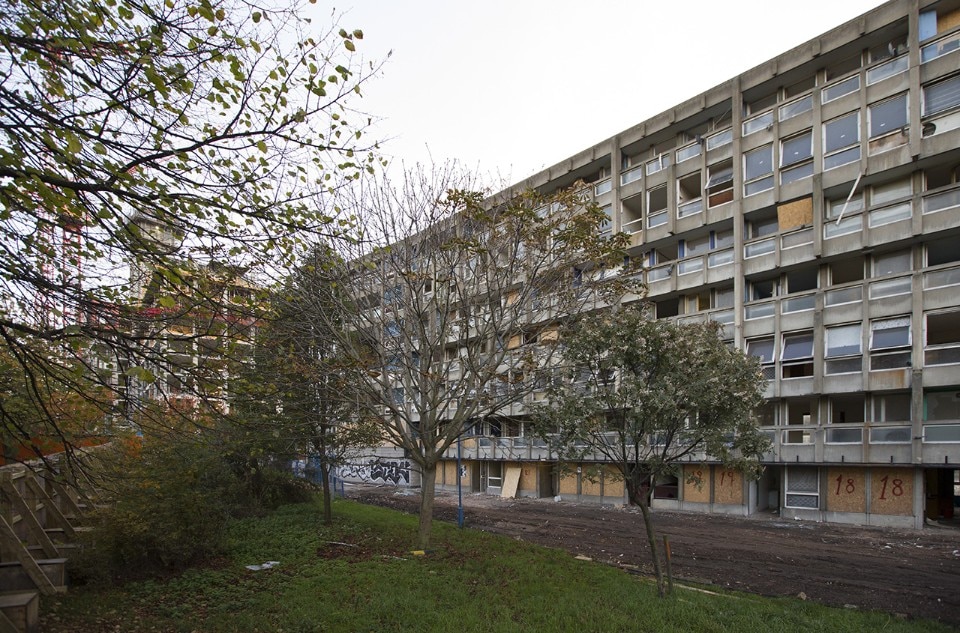
Robin Hood Gardens, completed 1972, designed by Alison and Peter Smithson. © The Victoria and Albert Museum, London
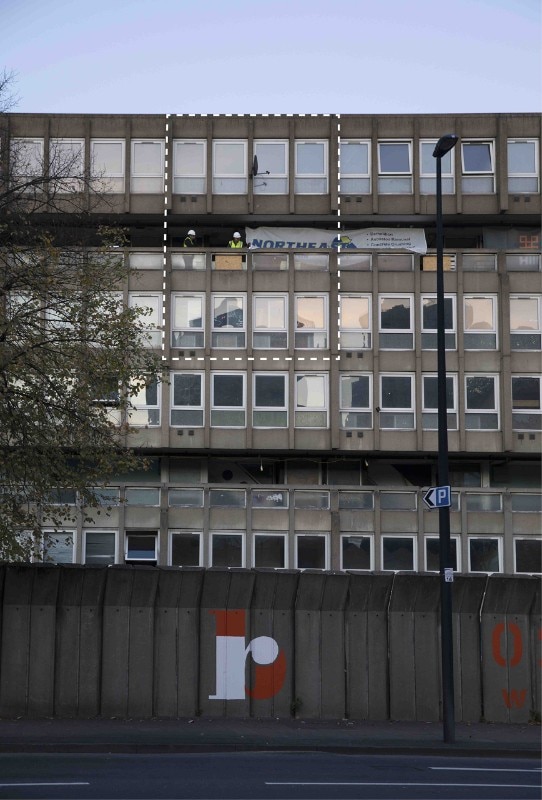
Robin Hood Gardens, completed 1972, designed by Alison and Peter Smithson. © The Victoria and Albert Museum, London
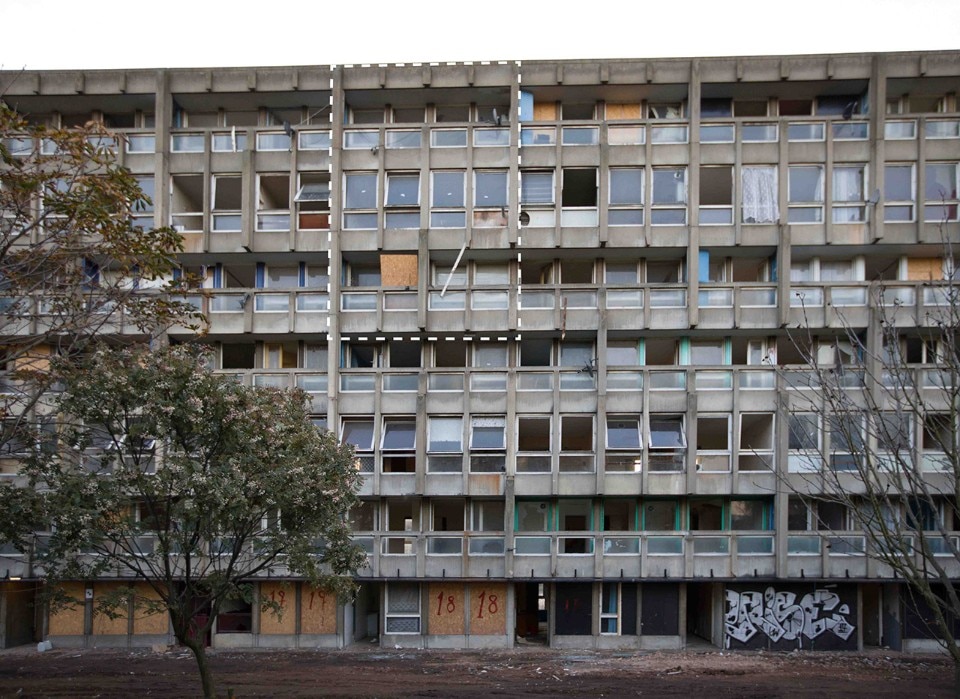
Robin Hood Gardens, completed 1972, designed by Alison and Peter Smithson. © The Victoria and Albert Museum, London

Robin Hood Gardens, Woolmore Street, London E14 0HG by Do Ho Suh commissioned by the V&A. Courtesy of the Artist, Lehmann Maupin, New York Hong Kong and Seoul and
Victoria Miro London / Venice. Photo Copyright © Victoria and Albert Museum, London

Robin Hood Gardens, Woolmore Street, London E14 0HG by Do Ho Suh commissioned by the V&A. Courtesy of the Artist, Lehmann Maupin, New York Hong Kong and Seoul and
Victoria Miro London / Venice. Photo Copyright © Victoria and Albert Museum, London

Robin Hood Gardens, Woolmore Street, London E14 0HG by Do Ho Suh commissioned by the V&A. Courtesy of the Artist, Lehmann Maupin, New York Hong Kong and Seoul and
Victoria Miro London / Venice. Photo Copyright © Victoria and Albert Museum, London

Reassembled fragment of the façade of Robin Hood Gardens, Pavilion of Applied Arts, La Biennale di Venezia, 2018. Photography: Mohamed Somji Photo Copyright © Victoria and Albert Museum, London.

View of upper storey of the fragment of Robin Hood Gardens, Pavilion of Applied Arts, La Biennale di Venezia, 2018. Copyright © Victoria and Albert Museum, London.

Side view of reassembled fragment of the façade of Robin Hood Gardens, Pavilion of Applied Arts, La Biennale di Venezia, 2018. Copyright © Victoria and Albert Museum, London.

Ground level façade and stairs, reassembled fragment of Robin Hood Gardens, Pavilion of Applied Arts, La Biennale di Venezia, 2018. Copyright © Victoria and Albert Museum,
London.

Exhibition entrance, Robin Hood Gardens: A Ruin In Reverse, Pavilion of Applied Arts, La Biennale di Venezia, 2018. Copyright © Victoria and Albert Museum, London.

Staircase to the street-in-the-sky, reassembled fragment of Robin Hood Gardens, Pavilion of Applied Arts, La Biennale di Venezia, 2018. Copyright © Victoria and Albert Museum,
London.

View from the street-in-the-sky, Robin Hood Gardens: A Ruin In Reverse, Pavilion of Applied Arts, La Biennale di Venezia, 2018. Copyright © Victoria and Albert Museum, London.

Robin Hood Gardens: A Ruin In Reverse, Pavilion of Applied Arts, La Biennale di Venezia, 2018. Copyright © Victoria and Albert Museum, London.

Model of the Robin Hood Gardens fragments supported by scaffolding, 2018. © muf architecture art

Robin Hood Gardens, completed 1972, designed by Alison and Peter Smithson. © The Victoria and Albert Museum, London

Robin Hood Gardens, completed 1972, designed by Alison and Peter Smithson. © The Victoria and Albert Museum, London

Robin Hood Gardens, completed 1972, designed by Alison and Peter Smithson. © The Victoria and Albert Museum, London

Robin Hood Gardens, completed 1972, designed by Alison and Peter Smithson. © The Victoria and Albert Museum, London
So it is not a coincidence that the design of Robin Hood Gardens began with the analysis of the industrial area of the docks. The designers immediately identified traffic, noise, air pollution, vandalism and lack of quality as the problems of our working life. They aimed to fight these issues not only for the first set of occupants of the complex, but also the following generations. The primary need was to protect the residential complex from the presence of city infrastructure. The effort to understand this difficult context is integrated in the planimetric layout of the two buildings, which stand at the boundaries of the lot with a north-south orientation, parallel to the busy streets edging it. The buildings thus enclose a central space: the stress-free zone, a common space free of vehicular traffic and dominated by an artificial hill built with the earth from the excavation of the foundations.
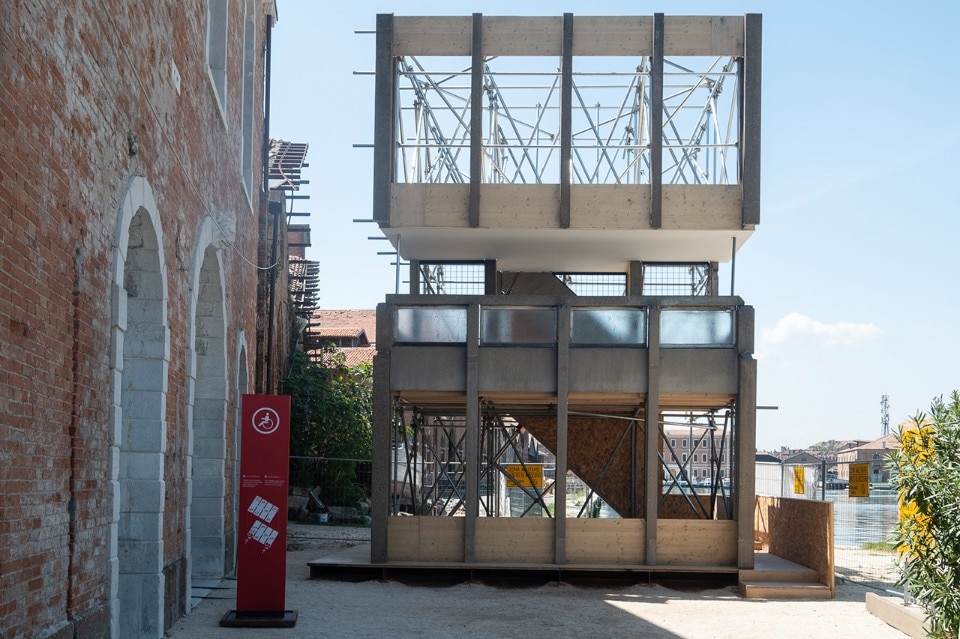
In section, the design further promotes this relationship: the residents’ car park on the underground floor is accessed from the outside. The stress-free zone is accessed only on foot, through specific passages. The interiors of the different types of apartments are organised according to the same criteria, meaning by placing the noisy areas of the living rooms facing the street, while the bedrooms and kitchens face the inside of the complex. The Smithsons imagined that parents in the kitchen could watch their children play in the green space that separate the two buildings, which respectively count seven and ten above-ground floors. Along the road, three-tonne concrete fins vertically punctuate the facade, aimed at minimising the transfer of sound. Also on the outside, two-metre-wide elevated “streets in the air” widen at the entrances of the individual units. Nomen est omen (Latin for “the name is a sign”): This element of urban derivation is the attempt to transpose and distribute the sociality of the street to the various floors of the two blocks. A cut-out section of one of these streets in the air is on display at the Applied Arts Pavilion in Venice to represent architecture’s approach to the human facts that were so central to the research on collective housing conducted by the Smithsons and their generation.
From the outset, the housing project was criticised and after a while, vandalised. The curators of the exhibition “Robin Hood Gardens: A Ruin in Reverse” at the Venice Biennale, Christopher Turner and Olivia Horsfall Turner, talk about how “the architects were blamed for the high crime rate in the complex”, and that the Smithsons “were shocked at the speed with which this happened”. Paraphrasing Peter Smithson, they said: “Sometimes inhabitants treat their direct properties differently from the common spaces. We suppose the issue here is to understand how to design behaviour, meaning how to bring people to respond in a certain way to the built space.”
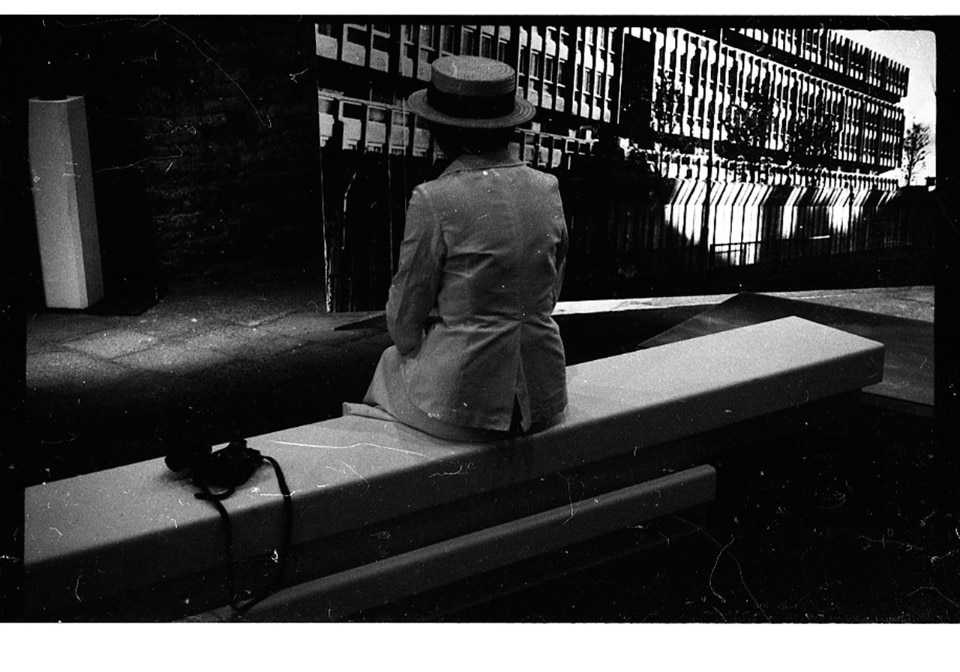
This is the third collaboration between the Biennale and the Victoria and Albert Museum. The exhibition is part of a wider research project conducted by the museum, which aims to develop a debate on housing construction between architects, scholars and inhabitants. The latter group is the subject of a substantial part of the exhibition, where it is documented how residents have taken possession of architecture and its ability to bring dignity to their lives. Less than 50 years after its completion, Robin Hood Gardens continues to be a point of reference in the contemporary debate on collective and social housing. What we’ve learnt from Alison and Peter Smithson is to use experimentation as an opportunity to make available to architecture tools with which to design the relationships people have with the buildings they inhabit in increasingly dense cities.
This article was originally published in Domus Paper, a special issue attached to Domus 1028, October 2018, and freely distributed in Milan during the Brera Design Days.
- Exhibition title:
- Robin Hood Gardens: A Ruin in Reverse
- Pavilion:
- special project, V&A Museum
- Curators:
- Christopher Turner, Olivia Horsfall Turner
- Venue:
- Applied Arts Pavilion, Arsenale, Venice Biennale
- Exhibition dates:
- 26 May – 25 November 2018
- Address:
- Campiello Tana 2169/F, Venice


